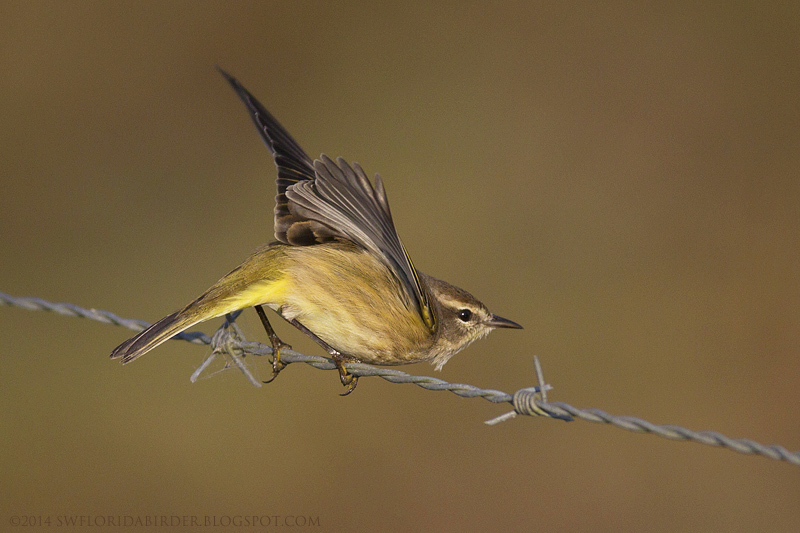A 15 November trip to Felda's Church Road was my last effort to observe the specialties through this publication.
The sunrise above (image 1) was photographed at Church Road in November 2014.
Though I missed the Western Kingbird and Scissor-tailed Flycatcher once again, Tom Wymelenberg got them the next day. A most interesting experience was had with overflights of a crop duster during my visit.
The Turkey Vulture above (image 2) was photographed at Church Road in November 2014.
The Killdeer above (image 3) was photographed at Church Road in November 2014.
The crop duster aircraft above (image 4) was photographed at Church Road in November 2014.
The coyote above (image 5) was photographed at Church Road in November 2014.
The Fish Crow above (image 6) was photographed at Church Road in November 2014.
The crop duster aircraft above (image 7) was photographed at Church Road in November 2014.
The plane made several approaches toward me from the orange groves it was treating. Before I got a whiff of the chemical resulting in my immediate departure a coyote was flushed from one side of the canal to the other.
The Double-crested Cormorant above (image 8) was photographed at Church Road in November 2014.
The crop duster aircraft above (image 9) was photographed at Church Road in November 2014.
The crop duster aircraft above (image 10) was photographed at Church Road in November 2014.
The Crested Caracara above (image 11) was photographed at Church Road in November 2014.
The Lesser Yellowlegs above (image 12) was photographed at Church Road in November 2014.
The Sandhill Crane above (image 13) was photographed at Church Road in November 2014.
I had adjusted the camera aperture setting to accommodate a slow shutter speed to allow a blur of the plane's propeller. When photographing the coyote the result was that it was almost blurred beyond recognition unfortunately.
The Loggerhead Shrike above (image 14) was photographed at Church Road in November 2014.
The Palm Warbler above (image 15) was photographed at Church Road in November 2014.
The Great Egret above (image 16) was photographed at Church Road in November 2014.
The Wood Stork with Roseate Spoonbill above (image 17) was photographed at Church Road in November 2014.
The Wood Stork above (image 18) was photographed at Church Road in November 2014.
The Wood Stork above (image 19) was photographed at Church Road in November 2014.
Onward to the west I was compelled to stop for further observations. I'm quite sure a Snipe was inadvertently flushed while walking along the roadside. The bird landed close but well beyond my unaided eye.
The Wood Stork above (image 20) was photographed at Church Road in November 2014.
The Roseate Spoonbill with Wood Stork above (image 21) was photographed at Church Road in November 2014.
The Anhinga above (image 22) was photographed at Church Road in November 2014.
The Crested Caracara above (image 23) was photographed at Church Road in November 2014.
The Crested Caracara above (image 24) was photographed at Church Road in November 2014.
The Crested Caracara above (image 25) was photographed at Church Road in November 2014.
Crested Caracara that had disappeared completely from view on my previous visit to Church Road allowed two birds for observation this trip. Visual differences between them are interesting here.
The Crested Caracara above (image 26) was photographed at Church Road in November 2014.
The Crested Caracara above (image 27) was photographed at Church Road in November 2014.
The Crested Caracara above (image 28) was photographed at Church Road in November 2014.
The mature Crested Caracara above (image 29) was photographed at Church Road in November 2014.
The immature Crested Caracara above (image 30) was photographed at Church Road in November 2014.
The Tree Swallow above (image 31) was photographed at Church Road in November 2014.
I devoted quite a bit of time attempting to photograph an abundant number of Tree Swallow that appeared to be in a flock of about 100. The most recent local reports put them in much greater numbers.
The American Kestrel above (image 32) was photographed near Harns Marsh Preserve in November 2014.
The American Kestrel seen above was in the area near Harns Marsh Preserve while looking for a Fox Squirrel.

































The bird you ID'd as a DCCO in #22 is actually an Anhinga.
ReplyDeleteThank you, AMR. I think I've misidentified the ANHI before. Must stop using copy and paste. I am grateful to Artie Morris for telling me that I misidentified a "western" which was actually a White-rumped Sandpiper . No time here to find that travesty.
DeleteAwesome photography Bob -- loved the Caracara flight shots!
ReplyDeleteThank you, Hemant. The battery charger has almost stopped blinking. Time to roll.
DeleteI love the cara cara pictures! Absolutely beautiful! i've always wanted to get a picture of a cara cara. I live in Port Charlotte...how far of a ride is it to Church Rd from where I live?
ReplyDeleteThank you! Adele
Thank you, Adele. From Veterans Parkway in Port Charlotte, you should allow about 75 minutes to make the drive. Caracara were abundant at Church Road today at sunrise. Western Kingbird and Scissor-tailed Flycatcher were also seen later in the morning.
ReplyDelete